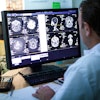Over the past 10 years, the salary gap between academic and nonacademic radiologists has decreased, according to a study published November 12 in the Journal of the American College of Radiology.
The trend matters in an era of physician shortages and boosted imaging volume post-COVID-19, wrote a team led by Ajay Malhotra, MD, of Yale School of Medicine in New Haven, CT.
"Given increasing [imaging] volumes, appropriate radiologist staffing is imperative, requiring both academic and nonacademic practices to adapt and offer increasingly competitive packages and creative coverage models," the group noted. "While a variety of factors are important in recruitment and retention, financial compensation is key."
As more and more radiology practices consolidate and assimilate into hospitals and healthcare networks, "the divide between academic and nonacademic practice has blurred," the authors wrote. But the differences between academic and nonacademic radiologist salaries and clinical workload have not been thoroughly investigated.
To address the knowledge gap, Malhotra and colleagues conducted a study that included survey data from the Medical Group Management Association (MGMA) for 2,883 diagnostic radiology and 886 interventional radiology physicians. They found the following:
- Nonacademic radiologists had greater total median salaries in 2023 than their academic peers in both diagnostic radiology (by 27%) and interventional radiology (by 32%).
- Between 2014 to 2023, median total compensation for diagnostic radiology increased by 18% overall (1.9% annually) for nonacademic radiologists and 32% overall (3.2% annually) for academic radiologists.
- In 2023, diagnostic radiologists produced greater median work relative value units (wRVUs) than interventional radiologists (by 53% for nonacademic and by 46% for academic radiologists), but interventional radiologists had higher compensation (by 16% in nonacademic and 10% in academic settings).
- Interventional radiologist salaries increased over the last decade (by 3.9% and 3.4% annually for nonacademic and academic clinicians), but median wRVUs trended downward (by -1.5 % annually for nonacademic and -2.4 % for academic physicians).
The group noted that "differences in compensation between practice settings (academic versus nonacademic) may be less directly connected to collections/RVU production due to the differences in operational structure and the need to reward nonclinical contributions in academic medical centers."
In any case, the study results could help radiology practices of all kinds better handle staffing and ensure patient access to imaging.
"As the practice of radiology evolves, further research into more of the specifics by practice setup is necessary to better understand the influencing factors," Malhotra and colleagues concluded. "Utilizing this data could help in addressing staffing and ensuring access to care for patients, negotiations for subsidies, or additional sources of funding, especially in the face of decreasing reimbursements."
The complete study can be found here.



















